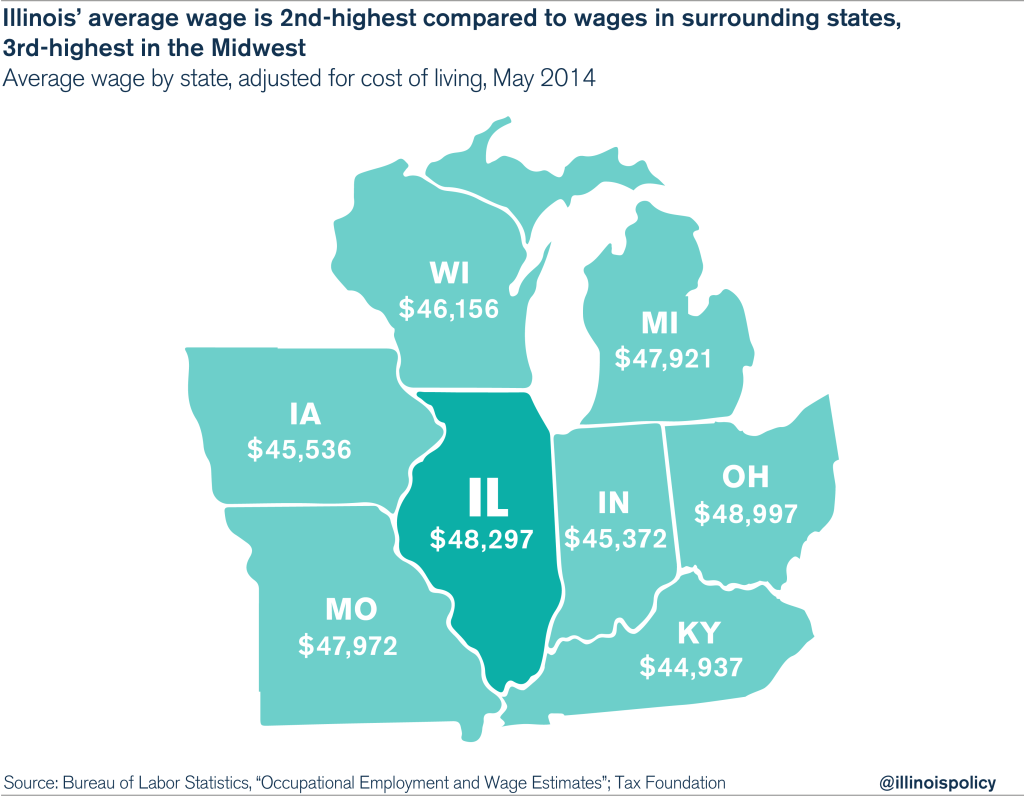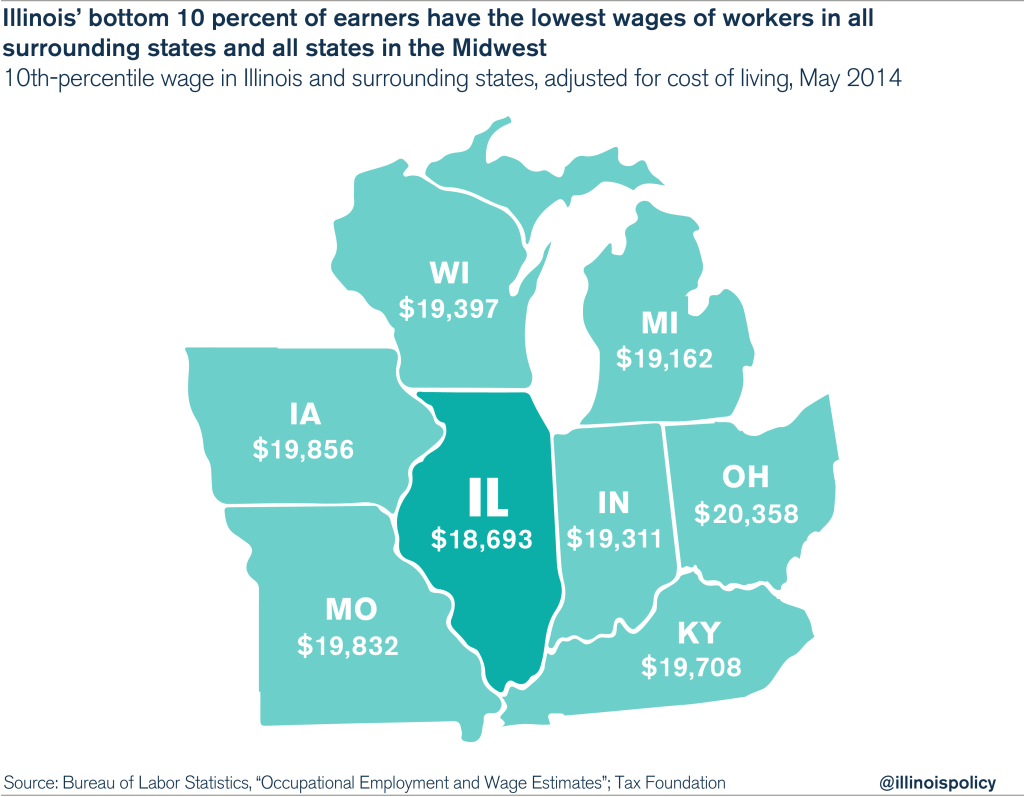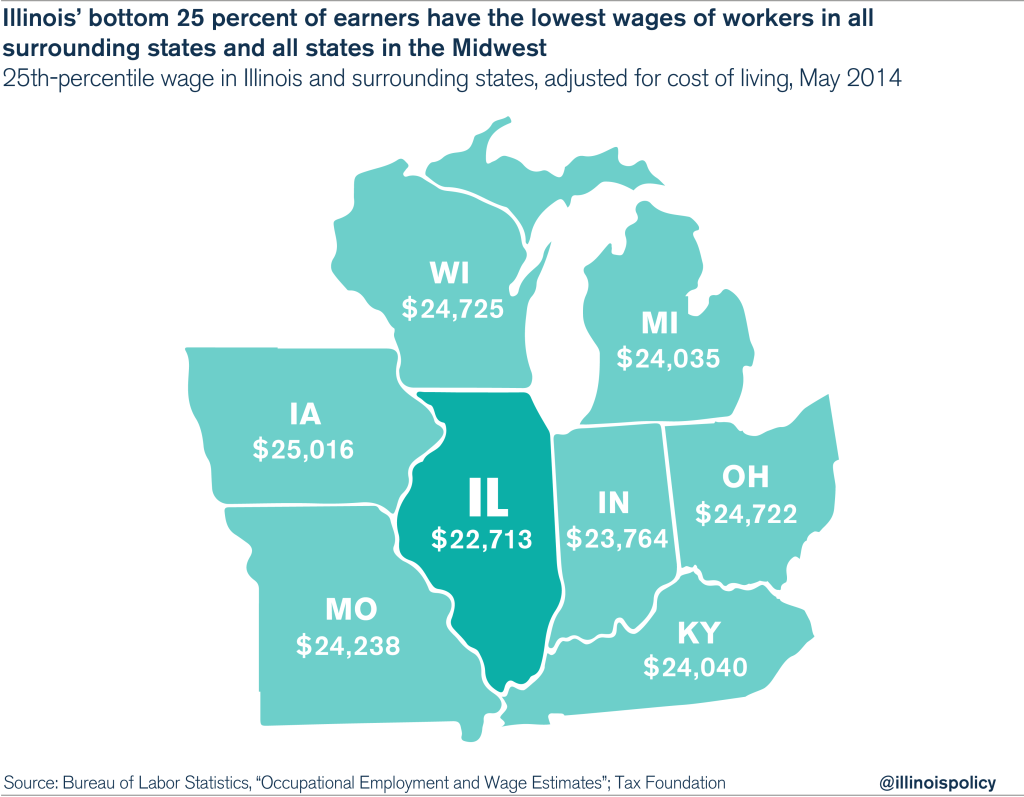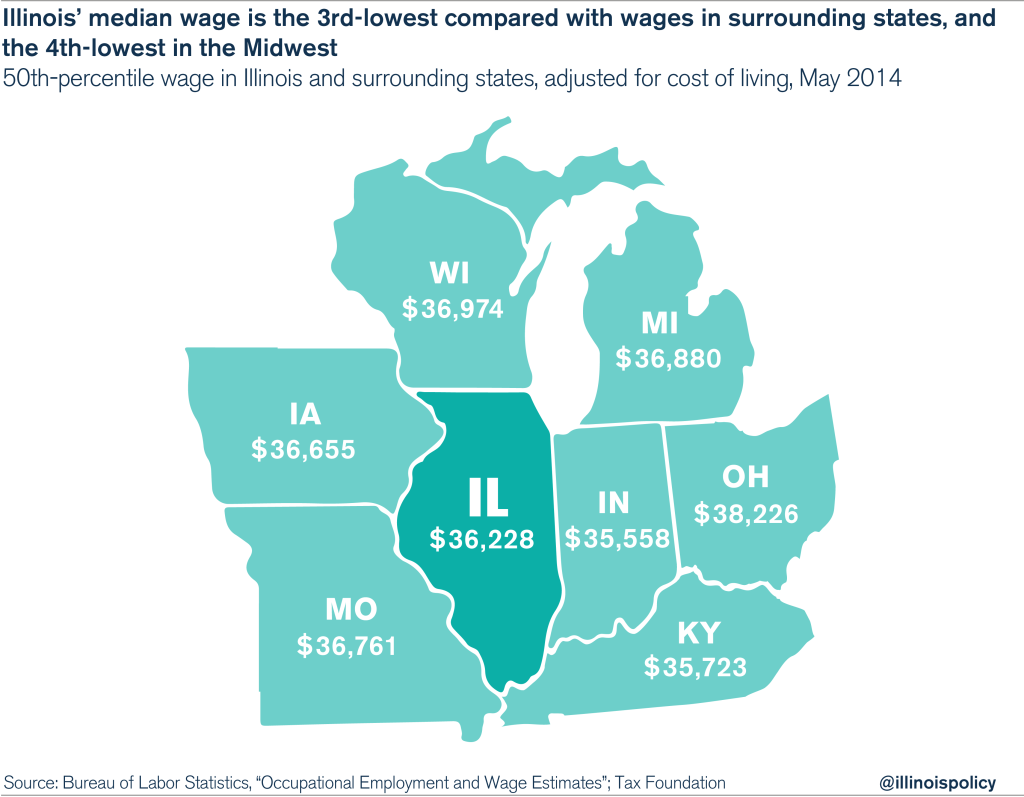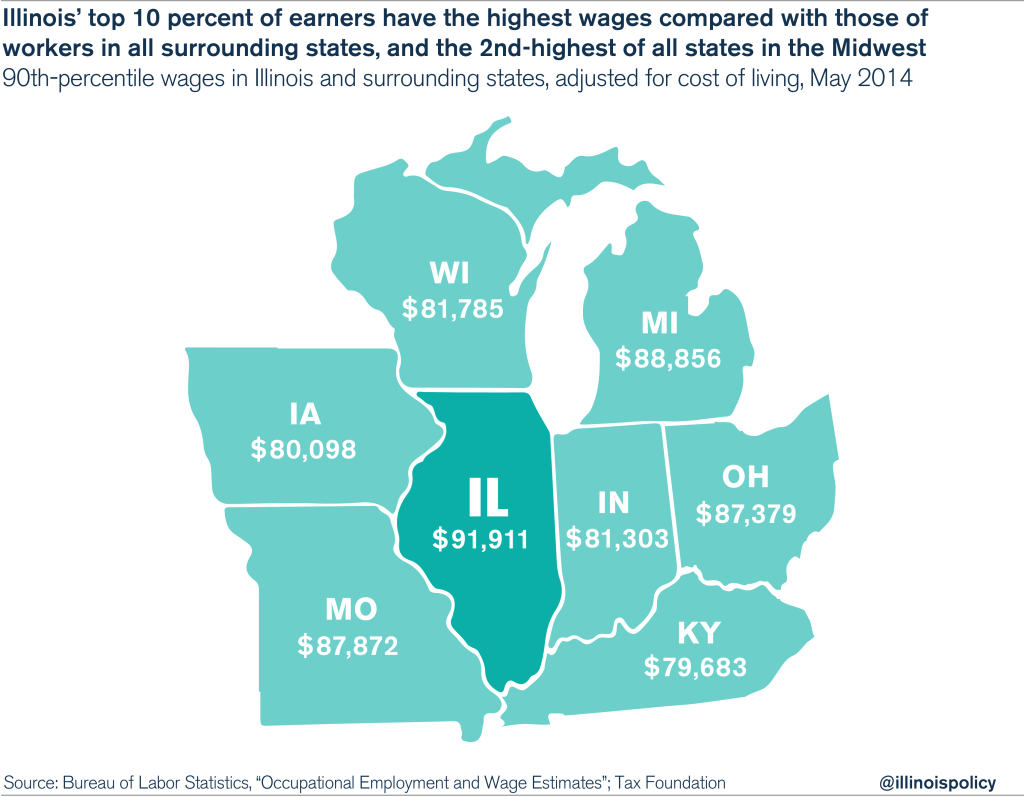Illinois’ low-income and blue-collar workers are the worst-paid in the region
Although Illinois’ top earners make more than most of their regional counterparts, Illinois’ bottom quarter of earners have the lowest wages in the Midwest
Though Illinois has the third-highest average wage in the Midwest, the state’s low-income and blue-collar workers are the worst-paid in the region, according to data from the Bureau of Labor Statistics.
Illinois’ anti-industry, anti-worker laws are thwarting the growth of blue-collar jobs and leaving blue-collar workers with lower wages and fewer opportunities. Good job opportunities in sectors such as manufacturing are disappearing from Illinois but growing in surrounding states. The status quo in Illinois simply isn’t working for those who need economic growth the most.
Much of the budget debate in Springfield revolves around whether the economic reforms put forth by Gov. Bruce Rauner will bolster the jobs and wages of Illinois’ middle- and lower-income workers. Rauner has maintained that economic reforms, including changes to the state’s lawsuit climate, workers’ compensation system and property taxes, are necessary to encourage economic growth and job creation. But Speaker Mike Madigan and his caucus have resisted reforms, claiming they are irrelevant to state budget negotiations and would harm the middle class.
The truth is that middle- and lower-income workers in Illinois are suffering because of the very status quo that Democratic politicians like Madigan are fighting to maintain.
Wage comparisons: Illinois vs. the rest of the Midwest
The average wage in Illinois ranks second among Illinois’ neighboring states and the Great Lakes states of Ohio and Michigan. Among these eight states, Illinois’ average wages are behind only Ohio’s. And Illinois has the third-highest average wage in the Midwest, which comprises Illinois, Indiana, Iowa, Kansas, Michigan, Minnesota, Missouri, Nebraska, Ohio, North Dakota, South Dakota and Wisconsin.
But the average wage does not reveal how Illinois compares across the spectrum of wages, from low earners to top earners. The Bureau of Labor Statistics compiles wage rates in each state at the 10th, 25th, 50th, 75th and 90th percentiles, which illustrate how workers are doing across the income spectrum. Illinois’ 10th – and 25th-percentile income earners are the worst-paid in the region, while its 75th– and 90th-percentile earners are some of the best-paid.
Illinois wage earners in the 10th percentile earn more than only 1 in 10 workers in Illinois, and less than 9 in 10 workers in Illinois. The 10th-percentile wage earner in Illinois makes $18,693 per year, after adjusting for the cost of living. These workers are the lowest-paid compared to their 10th-percentile counterparts in surrounding states; they are also the lowest-paid in the entire Midwest.
The 25th percentile of wage earners in Illinois make more than 1 in 4 workers in Illinois, and less than 3 in 4 workers in Illinois. The 25th-percentile wage earner takes home $22,713 per year in Illinois, after adjusting for the cost of living. That makes Illinois’ 25th-percentile wage earners the lowest-paid compared with their 25th-percentile counterparts in surrounding states, and the lowest-paid in the Midwest. Illinois workers in this group earn $1,000 per year less than their counterparts in Indiana, $1,500 less than their counterparts in Missouri, and $2,000 per year less than their counterparts in Wisconsin.
The 50th percentile of wage earners make what is known as the median wage. Half of Illinois workers earn more than the median, and half earn less. In Illinois, the median wage is $36,228 per year after adjusting for the cost of living, better than only Indiana and Kentucky of neighboring states, and only the ninth-best in the Midwest. The worker earning the median wage in Illinois is worse off than in most other places in the Midwest, earning $530 less than his peers in Missouri, $650 less than his counterpart in Michigan, and $750 less than a similar worker in Wisconsin.
At the 75th percentile of wages, Illinois workers pull ahead of their peers in surrounding states. The Illinoisan at the 75th percentile makes more than 3 of 4 Illinois workers, and less than 1 of 4 workers in the state. These workers in Illinois are the second-best-paid compared to their 75th-percentile counterparts in surrounding states, behind only Ohio. Illinois’ 75th-percentile workers’ earnings rank third in the Midwest.
Finally, the worker at the 90th percentile in Illinois makes more than 9 of 10 workers in the state. Illinois’ 90th-percentile wage is $91,911 per year after adjusting for the cost of living, the highest of 90th-percentile counterparts in surrounding states, and the second-highest in the Midwest.
It is undoubtedly a tremendous benefit to Illinois to have some of the top earners in the Midwest. A growing tech sector and new corporate headquarters in Chicago are good for the city and the state. But policymakers shouldn’t ignore the plight of those in blue-collar industries just because there are well-paying jobs in Chicago for lawyers, bankers and tech workers.
The boost to the state’s average wage provided by Illinois’ top earners can obscure the fact that Illinois’ bottom half of earners do poorly compared to their peers in surrounding states.
The bottom quarter of wage earners in Illinois are the worst off in the entire Midwest. Illinois’ anti-industry, anti-blue-collar-worker policies are regressive because they suppress job growth in blue-collar industries. Those who most need work opportunities in Illinois are least likely to find decent jobs. This helps explain Illinois residents’ skyrocketing enrollment in the food-stamps program, and the fact that the portion of Illinois’ population on food stamps is higher than that of any state in the region.
The industries in which Illinoisans fare worse than the rest of the Midwest are blue-collar. The analysis data will be discussed more completely in a future research report from the Illinois Policy Institute, but the initial results are startling. Workers in production, transportation and material moving, and health care support earn less in Illinois than in any other state in the Midwest. Food-preparation and -service workers in Illinois make less than their counterparts in every Midwestern state except Minnesota. These four blue-collar occupational categories account for more than one-quarter of all Illinois jobs. Their low wages and weak growth prospects are a disaster for blue-collar workers in the Land of Lincoln.
The data from the Bureau of Labor Statistics show that the policies that drive out blue-collar industries – such as Illinois’ broken workers’ compensation system, anti-business lawsuit climate and skyrocketing property taxes, as well as the state’s cronyism and overall anti-business atmosphere – also drive down the wages and job prospects of low-income and blue-collar workers. Blue-collar job prospects in Illinois are dim, and blue-collar jobs created in Illinois don’t pay well.

